“Many Roads Through Paradise,” a group exhibition recently unveiled at Barefoot, features the works of eleven artists from various corners of Sri Lanka. Each artist expresses his/her unique artistic journey, drawing inspiration from their surroundings, backgrounds, and personal stories that showcase the rich diversity of landscapes, biodiversity, cultures, and the experiences of people. Curated by Vidhi Todi.
This week’s Youth Observer features a cover by Ariyamalar Sasireka, whose beautiful collage reflects the paddy fields located just a few kilometers from her village, where local communities cultivate the land for survival.
Here’s what we discovered about the missions behind the amazing artworks of the eleven artists. The exhibition will go until 2nd November.
Ecological disruption
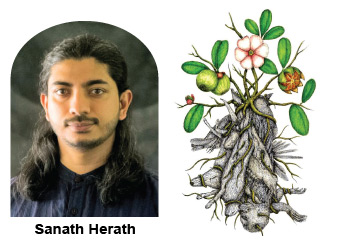 Sanath Herath’s artistic vision addresses the ecological disruption caused by foreign species in Sri Lanka’s landscapes through his series Eclipse of the Native. He captures the “delicate dance of life,” highlighting the silent encroachment of invasive plants that “weave a tapestry of monotony,” resulting in the loss of biodiversity. His deep connection to nature, cultivated during his upbringing in the central hills of Kandy and furthered by his studies in landscape architecture, informs his practice. By contrasting the monochrome depictions of native plants with the vivid colors of invasive species, he emphasizes their aggressive dominance and the resulting ecological imbalance. Sanath acknowledges that “death is a natural part of life,” yet he distinguishes that from the unnatural demise caused by invasives, which degrade ecosystems. His work serves as a “visual lament and a call to action,” urging viewers to confront irreversible changes in nature and recognize the need to preserve fragile ecosystems. Through his art, Sanath aims to raise awareness and inspire renewed commitment to conservation and the protection of native landscapes.
Sanath Herath’s artistic vision addresses the ecological disruption caused by foreign species in Sri Lanka’s landscapes through his series Eclipse of the Native. He captures the “delicate dance of life,” highlighting the silent encroachment of invasive plants that “weave a tapestry of monotony,” resulting in the loss of biodiversity. His deep connection to nature, cultivated during his upbringing in the central hills of Kandy and furthered by his studies in landscape architecture, informs his practice. By contrasting the monochrome depictions of native plants with the vivid colors of invasive species, he emphasizes their aggressive dominance and the resulting ecological imbalance. Sanath acknowledges that “death is a natural part of life,” yet he distinguishes that from the unnatural demise caused by invasives, which degrade ecosystems. His work serves as a “visual lament and a call to action,” urging viewers to confront irreversible changes in nature and recognize the need to preserve fragile ecosystems. Through his art, Sanath aims to raise awareness and inspire renewed commitment to conservation and the protection of native landscapes.
Reinterpretation of everyday materials
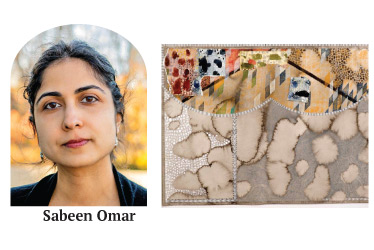 Sabeen Omar’s artistic vision intricately blends personal memory, cultural significance, and the reinterpretation of everyday materials. Drawing from her recollections of her mother massaging her forehead with tiger balm, she explores how “cardboard boxes, handkerchiefs, and garment fragments can inherit the value of heirlooms,” emphasizing the emotional weight of seemingly disposable items. Her creative process involves repetitive patterns and intricate lattice structures, capturing the duality of meaninglessness and preciousness through the “additive and subtractive role” of needles. Inspired by the shifting shapes of the sky, Sabeen employs the Islamic architectural technique of ablaq to reflect her exploration of memory and space. Her cyclical approach mimics her mother’s labor, as she “massages layers of material into [handkerchiefs],” creating a transformative experience. Through her art, she evokes the intimate connection between memory and environment, celebrating the “ephemeral but infused with love” aspects of her journey, while bridging personal history with broader themes of home and belonging.
Sabeen Omar’s artistic vision intricately blends personal memory, cultural significance, and the reinterpretation of everyday materials. Drawing from her recollections of her mother massaging her forehead with tiger balm, she explores how “cardboard boxes, handkerchiefs, and garment fragments can inherit the value of heirlooms,” emphasizing the emotional weight of seemingly disposable items. Her creative process involves repetitive patterns and intricate lattice structures, capturing the duality of meaninglessness and preciousness through the “additive and subtractive role” of needles. Inspired by the shifting shapes of the sky, Sabeen employs the Islamic architectural technique of ablaq to reflect her exploration of memory and space. Her cyclical approach mimics her mother’s labor, as she “massages layers of material into [handkerchiefs],” creating a transformative experience. Through her art, she evokes the intimate connection between memory and environment, celebrating the “ephemeral but infused with love” aspects of her journey, while bridging personal history with broader themes of home and belonging.
Ceramic sculptures
 Asela Abeywardena’s artistic vision explores the intricate connections between ecology, ancestry, and personal memory through her series of ceramic sculptures. With a family history rooted in the land for over a century, she reflects on how rapid urbanization has transformed both the environment and the socio-cultural fabric of her community, stating, “Through this body of work, I have tried to indicate the remnants of fast depleting natural resources, remnants of the connection to ancestral wisdom and values, and remnants of memories which are held dear.” Her earliest memories of village life inform her understanding of nature as a symphony of experiences, where “thoughts, feelings, actions are minute parts of a symphony.” Utilizing ceramic clay for its versatility and elemental connections—earth, air, fire, and water—Asela seeks to innovate within the Sri Lankan art scene. Influenced by the Japanese philosophy of Wabi-Sabi, she embraces impermanence, resulting in fragmented forms that reflect the organic nature of her work. Her artistic journey is marked by a commitment to enhance well-being through art, illustrated by her accolades, including first place at the Dubai Ceramics Award in 2017.
Asela Abeywardena’s artistic vision explores the intricate connections between ecology, ancestry, and personal memory through her series of ceramic sculptures. With a family history rooted in the land for over a century, she reflects on how rapid urbanization has transformed both the environment and the socio-cultural fabric of her community, stating, “Through this body of work, I have tried to indicate the remnants of fast depleting natural resources, remnants of the connection to ancestral wisdom and values, and remnants of memories which are held dear.” Her earliest memories of village life inform her understanding of nature as a symphony of experiences, where “thoughts, feelings, actions are minute parts of a symphony.” Utilizing ceramic clay for its versatility and elemental connections—earth, air, fire, and water—Asela seeks to innovate within the Sri Lankan art scene. Influenced by the Japanese philosophy of Wabi-Sabi, she embraces impermanence, resulting in fragmented forms that reflect the organic nature of her work. Her artistic journey is marked by a commitment to enhance well-being through art, illustrated by her accolades, including first place at the Dubai Ceramics Award in 2017.
Deeply rooted to her homeland
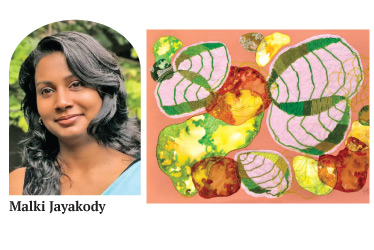 Malki Jayakody’s artistic vision is deeply rooted in her profound connection to her homeland, specifically the diverse landscapes of Sri Lanka. With a BA in Visual Arts and Design and experience as an Assistant Lecturer, Malki utilizes her education to explore the “soul bond” between herself and her land. An ardent nature lover, she aims to capture the “diversity, vividness, and inspiration of Mother Nature” in her works. Through her collection, she focuses on the scenic beauty of her surroundings, depicting “the aesthetic beauty of both visible and inviable environment” while melding her creativity with the unique climatic patterns and ecological features of Sri Lanka. Malki employs symbolic images, line patterns, and textures reminiscent of maps to highlight the rich ecological diversity and convey the interrelationships between humanity and nature. By doing so, she aspires to raise awareness of the complexities of this relationship, stating that her primary objective is to “disseminate awareness among the audience” on how to appreciate the multifaceted yet admirable bond between humans and the natural world, illuminating the contrasts between beauty and aridity in the environment.
Malki Jayakody’s artistic vision is deeply rooted in her profound connection to her homeland, specifically the diverse landscapes of Sri Lanka. With a BA in Visual Arts and Design and experience as an Assistant Lecturer, Malki utilizes her education to explore the “soul bond” between herself and her land. An ardent nature lover, she aims to capture the “diversity, vividness, and inspiration of Mother Nature” in her works. Through her collection, she focuses on the scenic beauty of her surroundings, depicting “the aesthetic beauty of both visible and inviable environment” while melding her creativity with the unique climatic patterns and ecological features of Sri Lanka. Malki employs symbolic images, line patterns, and textures reminiscent of maps to highlight the rich ecological diversity and convey the interrelationships between humanity and nature. By doing so, she aspires to raise awareness of the complexities of this relationship, stating that her primary objective is to “disseminate awareness among the audience” on how to appreciate the multifaceted yet admirable bond between humans and the natural world, illuminating the contrasts between beauty and aridity in the environment.
Identity, memory and transformation
 Rupaneethan Pakkiyarajah’s artistic vision intricately weaves together the themes of identity, memory, and transformation, as exemplified in his series ‘Roots of Echoes of Self’. Through abstract forms that evoke organic cellular structures, he explores the complexities of self-exploration and displacement, inviting audiences to reflect on their own internal landscapes. He expresses, “I encourage the viewer to reconsider the delicate relationship between human existence and the forces that shape and mold it.” This exploration is deeply personal for Rupaneethan, shaped by his own experiences with the culture of hazing and the trauma it inflicted on his sense of self and masculinity. His early fascination with rubber materials was sparked during a time of introspection amidst physical and mental suffering, leading to his university exhibition, My Soft Skin, where he contemplated the intersections of “body” and “land.” As he observes, “the land bore the weight of these struggles,” illustrating how personal and collective traumas are intrinsically linked. Having pursued a Master’s degree in Decorative and Applied Art and Folk Crafts, Rupaneethan’s evolving practice now encompasses various mediums that challenge traditional notions of gender and explore the inter-connectedness of humanity and nature.
Rupaneethan Pakkiyarajah’s artistic vision intricately weaves together the themes of identity, memory, and transformation, as exemplified in his series ‘Roots of Echoes of Self’. Through abstract forms that evoke organic cellular structures, he explores the complexities of self-exploration and displacement, inviting audiences to reflect on their own internal landscapes. He expresses, “I encourage the viewer to reconsider the delicate relationship between human existence and the forces that shape and mold it.” This exploration is deeply personal for Rupaneethan, shaped by his own experiences with the culture of hazing and the trauma it inflicted on his sense of self and masculinity. His early fascination with rubber materials was sparked during a time of introspection amidst physical and mental suffering, leading to his university exhibition, My Soft Skin, where he contemplated the intersections of “body” and “land.” As he observes, “the land bore the weight of these struggles,” illustrating how personal and collective traumas are intrinsically linked. Having pursued a Master’s degree in Decorative and Applied Art and Folk Crafts, Rupaneethan’s evolving practice now encompasses various mediums that challenge traditional notions of gender and explore the inter-connectedness of humanity and nature.
Land, a tactile archive
 T. Krishnapriya’s artistic vision intricately weaves together the concepts of land, belonging, and memory. She articulates that the land “not only offers itself as a visual metaphor of lived experiences but also a tactile archive,” creating a bridge between the natural world and human habitation. Her paintings function as “visceral geographical annotations and recordings,” using the tools of cartography to explore the complex dynamics of identity and belonging. Through lines and markings that traditionally organize space, Krishnapriya highlights the “fragile balance” between physical landscapes and the human experience, capturing moments of movement and journeying across boundaries of time and place. She expresses that her work serves as “an abstract rendering of a concrete reality,” inviting viewers to engage with the subversive dualities that emerge from her exploration of memory and imagination. Ultimately, her art conveys that “the drawing represents experience rather than appearance,” transcending mere perception to connect deeply with the viewer’s understanding of their own narratives and histories.
T. Krishnapriya’s artistic vision intricately weaves together the concepts of land, belonging, and memory. She articulates that the land “not only offers itself as a visual metaphor of lived experiences but also a tactile archive,” creating a bridge between the natural world and human habitation. Her paintings function as “visceral geographical annotations and recordings,” using the tools of cartography to explore the complex dynamics of identity and belonging. Through lines and markings that traditionally organize space, Krishnapriya highlights the “fragile balance” between physical landscapes and the human experience, capturing moments of movement and journeying across boundaries of time and place. She expresses that her work serves as “an abstract rendering of a concrete reality,” inviting viewers to engage with the subversive dualities that emerge from her exploration of memory and imagination. Ultimately, her art conveys that “the drawing represents experience rather than appearance,” transcending mere perception to connect deeply with the viewer’s understanding of their own narratives and histories.
Intersections of religion, race and gender
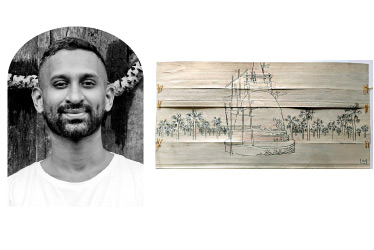 Malinda Jayasinghe’s artistic vision is a compelling exploration of the intersections of religion, race, and gender privilege within structures of power in Sri Lanka. Born into a Sinhala-Buddhist household and educated in an all-boys school, he draws upon his own identity and upbringing as critical sources for his work. With a background in Economics and Finance, Malinda transitioned into the visual arts in 2019, seeking to challenge the “ongoing oppression of minority communities by the dominant social groups” associated with his own cultural identity. His practice, which encompasses drawing, painting, and sculpting, utilizes traditional ola leaf manuscripts, “the main writing material and vehicle of knowledge in Sri Lanka for over 2000 years” to interrogate the construction of antiquity and the implications of land grabs in the Northern and Eastern provinces. In his critique, he plays with the dimensions of the national flag, employing “incomplete patterns and empty spaces” to underscore the present nature of occupation and emphasize the complicity of the military, clergy, and state in legitimizing ethno-religious claims.
Malinda Jayasinghe’s artistic vision is a compelling exploration of the intersections of religion, race, and gender privilege within structures of power in Sri Lanka. Born into a Sinhala-Buddhist household and educated in an all-boys school, he draws upon his own identity and upbringing as critical sources for his work. With a background in Economics and Finance, Malinda transitioned into the visual arts in 2019, seeking to challenge the “ongoing oppression of minority communities by the dominant social groups” associated with his own cultural identity. His practice, which encompasses drawing, painting, and sculpting, utilizes traditional ola leaf manuscripts, “the main writing material and vehicle of knowledge in Sri Lanka for over 2000 years” to interrogate the construction of antiquity and the implications of land grabs in the Northern and Eastern provinces. In his critique, he plays with the dimensions of the national flag, employing “incomplete patterns and empty spaces” to underscore the present nature of occupation and emphasize the complicity of the military, clergy, and state in legitimizing ethno-religious claims.
In harmony with nature
 Ariyamalar Sasireka is an artist from Batticaloa, deeply committed to representing the struggles and strengths of women through her work. Her artistic vision centers on the theme of harmony with nature, as she beautifully captures the essence of living in balance with the environment. As she states, “My painting activities speak about the women’s power and strengths of dreams and life without violence.” Her collage works reflect the intricate relationship between humanity and nature, showcasing both the struggles and the beauty found in daily life. Through her art, Sasireka emphasizes the collective labour and resilience of her community, particularly highlighting the collaboration between men and women in the fields. “I depict the beauty of plowing the fields to show the union between men and women in labour.”
Ariyamalar Sasireka is an artist from Batticaloa, deeply committed to representing the struggles and strengths of women through her work. Her artistic vision centers on the theme of harmony with nature, as she beautifully captures the essence of living in balance with the environment. As she states, “My painting activities speak about the women’s power and strengths of dreams and life without violence.” Her collage works reflect the intricate relationship between humanity and nature, showcasing both the struggles and the beauty found in daily life. Through her art, Sasireka emphasizes the collective labour and resilience of her community, particularly highlighting the collaboration between men and women in the fields. “I depict the beauty of plowing the fields to show the union between men and women in labour.”
In her work, Sasireka uses small pieces of magazines to create landscapes. She reflects on the diverse landscapes and dynamics found in nature, conveying that “living with nature is both beautiful and healthy.” Through this approach, she captures the intricate relationships within the environment and emphasizes its significance in her artistic expression.
Migration and identity
 Lojithan Ram’s artistic vision is deeply rooted in the theme of migration and the complexities of identity that arise from a life of constant displacement. He holds a Bachelor of Fine Arts and a Master of Fine Arts, which contribute to his nuanced understanding of these themes. He reflects on how migration has been “a constant epicenter” of his existence, leading to a sense of nostalgia that informs his identity. His work transforms personal memories and narratives into “a collage embodiment of the organic presence of migration and fragmented identities,” allowing viewers to engage with the tangible presence of his experiences. Drawing inspiration from mythological and literary texts such as the Bhagavad Gita and the Ramayana, Lojithan explores the parallels between his life and the “lives of gods, kings, and other characters in epic and literary stories,” all of whom share the universal experience of displacement and the search for belonging. He articulates this connection by stating, “I aim to include the lyrics of epic and literary stories directly into the artwork,” merging visual and verbal narratives to convey the complexities of his nomadic existence. Through this layered artistic practice, Lojithan seeks to reshape memories of the landscapes he has missed, ultimately uniting them under the “symbolic roof of a single home,” while highlighting the fragile acceptance of a constantly shifting reality.
Lojithan Ram’s artistic vision is deeply rooted in the theme of migration and the complexities of identity that arise from a life of constant displacement. He holds a Bachelor of Fine Arts and a Master of Fine Arts, which contribute to his nuanced understanding of these themes. He reflects on how migration has been “a constant epicenter” of his existence, leading to a sense of nostalgia that informs his identity. His work transforms personal memories and narratives into “a collage embodiment of the organic presence of migration and fragmented identities,” allowing viewers to engage with the tangible presence of his experiences. Drawing inspiration from mythological and literary texts such as the Bhagavad Gita and the Ramayana, Lojithan explores the parallels between his life and the “lives of gods, kings, and other characters in epic and literary stories,” all of whom share the universal experience of displacement and the search for belonging. He articulates this connection by stating, “I aim to include the lyrics of epic and literary stories directly into the artwork,” merging visual and verbal narratives to convey the complexities of his nomadic existence. Through this layered artistic practice, Lojithan seeks to reshape memories of the landscapes he has missed, ultimately uniting them under the “symbolic roof of a single home,” while highlighting the fragile acceptance of a constantly shifting reality.
Essence of island home
 Safiya Sideek is a Colombo-based visual artist whose work beautifully encapsulates the essence of her island home, Sri Lanka. Through her paintings, she seeks to evoke the harmony and tranquility of her surroundings, saying, “With every brushstroke, I bring to life the natural beauty of my homeland.” Having grown up in Abu Dhabi, Safiya grapples with the concept of home, feeling a mix of familiarity and discomfort during her yearly returns to Colombo. Her transformative journey took root in Melbourne, where she found refuge in nature, immersing herself in local foliage that starkly contrasted with the arid landscapes of the UAE. Reflecting on her evolving relationship with space, she notes, “The soothing rhythm of ocean waves and the gentle rustle of palm leaves comforted me.”
Safiya Sideek is a Colombo-based visual artist whose work beautifully encapsulates the essence of her island home, Sri Lanka. Through her paintings, she seeks to evoke the harmony and tranquility of her surroundings, saying, “With every brushstroke, I bring to life the natural beauty of my homeland.” Having grown up in Abu Dhabi, Safiya grapples with the concept of home, feeling a mix of familiarity and discomfort during her yearly returns to Colombo. Her transformative journey took root in Melbourne, where she found refuge in nature, immersing herself in local foliage that starkly contrasted with the arid landscapes of the UAE. Reflecting on her evolving relationship with space, she notes, “The soothing rhythm of ocean waves and the gentle rustle of palm leaves comforted me.”
Reflection of societal tensions
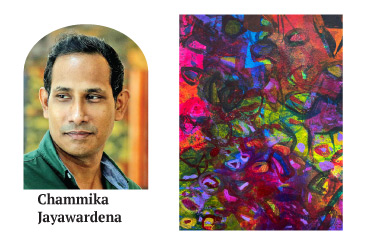 Chammika Jayawardena’s artistic vision transcends traditional representations of beauty, focusing instead on the powerful narratives embedded within the land he depicts. Holding a BFA from the University of Visual and Performing Arts in Colombo and an MA in Archaeology from the University of Kelaniya, he enriches his artwork with a deep understanding of cultural and historical contexts. He emphasizes that “this is not a scene captured in a classical sense for its beauty; for the pleasures of the elite. It is a land. A land on which many incidents had occurred.” Through his use of a “camouflage sky and the earth,” Chammika employs intersecting symbolic colors that resonate with the identities of various ethnic groups and religious-nationalist extremist factions in Sri Lanka. This intentional choice reveals how these colors dominate the landscape and reflect the societal tensions fueled by power and greed. As viewers engage with his work, they are invited to look beyond surface aesthetics and confront the historical and cultural complexities inherent in the land.
Chammika Jayawardena’s artistic vision transcends traditional representations of beauty, focusing instead on the powerful narratives embedded within the land he depicts. Holding a BFA from the University of Visual and Performing Arts in Colombo and an MA in Archaeology from the University of Kelaniya, he enriches his artwork with a deep understanding of cultural and historical contexts. He emphasizes that “this is not a scene captured in a classical sense for its beauty; for the pleasures of the elite. It is a land. A land on which many incidents had occurred.” Through his use of a “camouflage sky and the earth,” Chammika employs intersecting symbolic colors that resonate with the identities of various ethnic groups and religious-nationalist extremist factions in Sri Lanka. This intentional choice reveals how these colors dominate the landscape and reflect the societal tensions fueled by power and greed. As viewers engage with his work, they are invited to look beyond surface aesthetics and confront the historical and cultural complexities inherent in the land.







